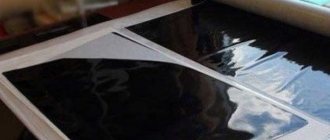Each car owner has a good idea of what his iron friend suffers during operation from the influence of the environment. When driving on roads, the body and its paintwork are especially vulnerable. Over time, chips of paint form, scratches on the body, and corrosion develops. How to protect your car or the most vulnerable body parts?
There has been armored film on cars on the market for many years now, it is also called protective or anti-gravel. It protects the entire car body or separately those places and elements that are most exposed.
Many car repair shops perform body wrapping work. Due to the simplicity of the gluing process and the relatively low cost of the material, you can carry out this operation yourself.
What kind of protective film is used and for what purposes?
Protective film is an artificial coating that protects the car body and its elements from damage. This is its main function. Additional – body styling*.
There are two types of films:
- Vinyl.
- Polyurethane.
Vinyl film was the first to be used for protection. In its physical and chemical composition, it most closely resembles plastic. It stretches when heated and when cooled turns into a hard plastic. Initially used to protect street advertising boards and billboards.
Polyurethane film has a different structure - it is soft, stretches at any temperature and returns to its original size. A synthetic polymer has properties similar to rubber. Acts as a damper*. It was developed in the USA for the needs of the Air Force, in particular, to protect helicopter blades from sand.
Essentially, both perform the same function - protecting the car body. The only difference is that vinyl protects due to its thickness, and polyurethane due to its physical properties, similar to rubber.
*styling - changing the appearance of a car... *damper - something that has a calming, softening effect...
Vinyl film
Vinyl film (PVC) was once invented for advertising on cars. Under no circumstances should it be taken as a protective agent. This is not its purpose, although the thickness of high-quality types of vinyl reaches 90 microns. True, when wrapping a car, it inevitably stretches and in difficult places it can become thinner by about 40%. At best, it will protect the body from sandblasting, road reagents and, for example, light scratches from branches, but no more. On the other hand, such a film has a huge range of colors and textures, giving absolute freedom of action to car styling enthusiasts. In addition, during the life of the vinyl, you can forget about caring for the paintwork of the car, which means considerable expenses - for example, on polishing the body. The average price tag for high-quality vinyl wrapping of an entire body in Moscow is 80–100 thousand rubles.
The plastic nature of PVC imposes a major limitation on the service life of such a film (on average 3–5 years). Over time, due to prolonged exposure to the sun, this material will heat shrink. In this case, in some places the film can warp, crack, peel off and rise on the edges of the body panels. PVC also does not tolerate temperature changes well. If you go to the car wash in severe frost, the film may crack during bath procedures. In addition, the plastic cover gets scratched quite quickly. This film does not absorb impacts from stones and breaks through.
Advantages and disadvantages
When there are two or more materials for any type of work, it is always difficult to give preference to one of them. To make it easier to make a decision in our case, we can compare the positive and negative properties of both types.
Vinyl film
Advantages:
- the coating protects the car body from damage caused by dirt, fine gravel, branches and sand;
- practically invisible on the body;
- minor defects are not visible on the body;
- protects the paintwork from ultraviolet radiation;
- variety of color;
- affordable price.
Flaws:
- short service life, instead of the stated 3-5 years, only 2-3 years;
- with strong impacts with large gravel, chips and cracks appear;
- Difficulties in dismantling when the coating has been used for more than two years, the glue and film harden, removing it can lead to peeling of the paint;
- fades under the influence of the sun, reacts negatively to reagents;
- a shagreen effect is possible.
It is 100 microns (0.1 mm) thick and transparent in appearance.
Polyurethane film
Advantages:
- durable, resistant to large chips and deep scratches;
- protects the paintwork from damage caused by gravel and pebbles;
- does not undergo deformation at high and low temperatures;
- does not tear, is resistant to damage even in minor accidents;
- service life from 5 to 10 years;
- can be polished;
- protection from reagents;
- There are no difficulties during dismantling; after removal it leaves no traces.
Flaws:
- high price, five times more expensive than vinyl;
- after gluing to the body, long-term drying;
- no protection against ultraviolet radiation.
Film thickness ranges from 150 to 300 microns. There is a positive side to the fact that polyurethane allows ultraviolet light to pass through. The partially coated car body will burn out evenly, and after removing it the color will be the same.
You can remove the polyurethane coating yourself, but it is better to remove the vinyl coating in a specialized workshop, otherwise there is a risk of damaging the surface of the body.
Which film is better to cover a car?
Today, there are two types of films for wrapping car bodies - vinyl and polyurethane. Vinyl-based film coverings are available in a variety of types and colors, which allows them to be used to transform the exterior design. Although they protect the paintwork of the body from exposure to ultraviolet radiation and minor damage, their protective properties are inferior to anti-gravel polyurethane films, which are only transparent and are used exclusively to protect the body.
Vinyl films are most often used for car tuning and styling, which is explained not only by their diversity, but also by their lower price.
Depending on the production method, such films come in two types:
- calendered;
- cast.
Vinyl films HEXIS
Cast films are of higher quality and more durable; they are available in a wider range of types and colors, but are somewhat more expensive than calendered films. Which film to choose for your car is up to everyone to decide for themselves. But, if you decide to wrap your car yourself, it is better to choose cast film, which is of higher quality and easier to work with. There are the following types of vinyl films (car vinyl):
- transparent and colored;
- matte and glossy;
- pearlescent and metallic effect films;
- graphic films intended for applying designs using digital printing methods;
- textured films, with a surface stylized to resemble various materials, which include carbon-look film coating;
- “chameleon” type films, the color of which changes under different viewing angles.
Vinyl film chameleon
The choice is really very large, and everything here depends on your taste, and on what effect you want to get by resorting to this kind of tuning. But, in any case, you need to buy film from well-known brands if you want it to easily fit on any body parts with complex surface topography and last as long as possible. The most popular and in demand in all countries of the world are the following brands:
- 3M Scotchprint (USA);
- KPMF (UK);
- Hexis (France);
- ORACAL (Germany).
To determine how much film will be needed for pasting, you need to know the area of all body elements to which it will be applied. It is quite difficult to make such exact measurements, therefore, to roughly calculate the need for material and its cost, they use data verified in practice.
For complete wrapping of a car body, which is recommended for use when using auto vinyl, the following film consumption is accepted, depending on the class of the car:
- compact B-class cars - from 18 to 21 sq. m;
- middle class cars (C-class) 23–24 m2;
- large family cars D-class 25–27 sq. m.;
- business class cars (E-class) - from 27 to 30 sq. m.;
- S-class sports coupe 30–34 m2;
- compact SUVs 25–30 sq. m;
- large SUVs 34–37 m2.
Vinyl film in rolls
It is best to buy car vinyl in rolls 1.52 m wide, so that when pasting large body elements, you do not have to make joints.
What areas are usually protected with film?
It is best to cover the entire surface of the body. But, based on the cost, especially of polyurethane film, you can paste over the part of the body and its elements that are most exposed to sand, stones, branches, etc.
The optimal installation of protection is the front of the car:
- bumper;
- the leading edge of the hood or the entire hood;
- front wings;
- exterior mirror housings;
- leading edge of roof;
- thresholds, doors in the lower part;
- around door handles.
To this you can add the wrapping of the rear bumper, which is at risk when reversing or in heavy traffic.
An approximate partial body wrap of a Toyota Land Cruiser is shown in the photo:
Is it possible to cover headlights with film?
Headlight armoring is an effective means of keeping your vehicle's lighting glass in excellent condition longer. Everything is very simple: sand and pebbles flying towards the car while driving will scratch the coating, not the glass. The film can always be replaced.
From the point of view of the legislation of the Russian Federation, there was a debate - whether it is possible to paste it over or not. The dispute arose due to a discrepancy in the interpretation of Article 12.4, the Code of Administrative Offenses of the Russian Federation, the Technical Regulations on the Safety of Wheeled Vehicles, a number of GOSTs and the List of faults and conditions under which the operation of vehicles is prohibited.
Fortunately, lawyers, through judicial practice, have sorted out this issue and proved that sticking a protective film on the headlights does not change the operating mode of the device. Therefore, protecting headlights is not prohibited by Russian legislation, but the lighting devices must shine white light.
Which is better, painting the body or wrapping it?
There is no clear answer to this question. Each type has its own advantages and disadvantages. Let's look at some of them.
Car body wrapping
- In terms of time, pasting is faster than painting.
- The cost of pasting is less than painting.
- The emission of harmful substances during pasting is less than during painting.
- The film preserves the paintwork.
- It is impossible to cover everything; some body shapes are easier to paint.
Car body painting
- Painting is more expensive.
- It takes more time to paint.
- High-quality painting requires specialists; it’s difficult to do it yourself.
- The paint weighs more than the film.
- Possibility of repeated polishing.
- Any part of the body can be painted.
You can accept one of the options, but if the car is new, it is better to cover it with film. If the car is used, treat its body and paint it. The decision is up to the owner.
Is it possible to bypass this rule?
In fact, there are quite a few ways to bypass the obligation to register color changes.
- In vehicle documents, color is indicated in a simplified form. For example, the color “aquamarine” is often listed as “blue-green,” which includes at least 3 other common automotive shades. Thanks to this, you can use a pasting that is part of a given color group, but differs in shade from the first color. There will be no problems with the State Traffic Inspectorate employees.
- Only changes covering more than 30% of the body need to be registered. If you cover only the roof, hood, trunk and part of the bumpers with a new color, you can significantly change the appearance of the car, within the 30% limit. In reality, not a single inspector will measure the exact percentage of body wrap, and even on those. Upon inspection, the percentage of pasting is often revealed only approximately.
- If 30% of the body is not enough and you want to change the look of the entire car, then you can use glossy, matte, carbon or any other film of the same color. There will be no need to make changes to the PTS, but the car will look completely new.
- Well, the last option is suitable for the most freedom-loving. According to the law, 5 days are given to make changes to the PTS. That is, the driver can repaint the car in absolutely any color, and at each stop the traffic police inspectors will answer that the film was pasted the other day and that the change will be registered in the near future. However, if a traffic police officer does not believe such a story (for example, due to the condition of the film), he will simply issue a fine. When appealing this punishment, the driver will have to provide evidence of innocence himself, otherwise the complaint will simply be rejected.









